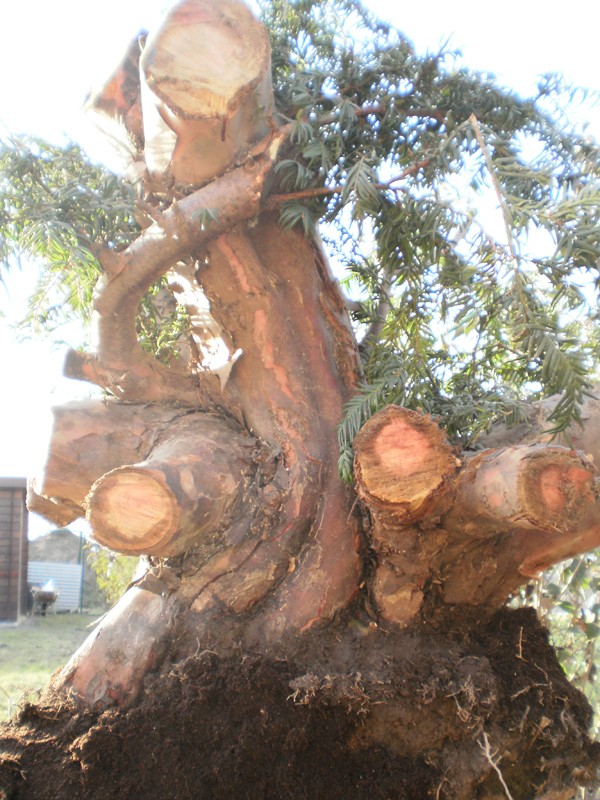Taxus Bacatta
+4
Jacos
bisjoe
peter keane
Wesley
8 posters
Page 1 of 1
 Taxus Bacatta
Taxus Bacatta
Hi,
Yesterday i found this taxus at an old house, that soon will be pulled down. The tree was already digged up, and it took 2 men to lift it.
Now i need to put it in the ground asap, and let it grow for the next two years, if it will survive.
On the first picture i placed a wine cork on it to get an idea of the size.
[img] [/img]
[/img]
[img] [/img]
[/img]
[img] [/img]
[/img]
[img] [/img]
[/img]
Yesterday i found this taxus at an old house, that soon will be pulled down. The tree was already digged up, and it took 2 men to lift it.
Now i need to put it in the ground asap, and let it grow for the next two years, if it will survive.
On the first picture i placed a wine cork on it to get an idea of the size.
[img]
 [/img]
[/img][img]
 [/img]
[/img][img]
 [/img]
[/img][img]
 [/img]
[/img]
Wesley- Member
 Re: Taxus Bacatta
Re: Taxus Bacatta
that's a great find! I came across two yews under similar circumstances. One was in a pile of them after being pulled by a backhoe. Another was on the sidewalk awaiting trash collection with roots up. In the second case, I was quite lucky that the weather was misting for two days prior to my finding it.
if realistic, I would inspect the shape of the rootball for making a wooden box 2 cm wider and deeper. I would fill the gap with a free-draining mix that has some peat humus or compost mixed in. Water sparingly to force feeder roots into the existing soil. Putting the tree in the ground for two years means that you'll have to collect it all over again.
oh yeah. one more point, spray the foliage with an anti-dessicant to prevent it from drying out until it produces new roots.
if realistic, I would inspect the shape of the rootball for making a wooden box 2 cm wider and deeper. I would fill the gap with a free-draining mix that has some peat humus or compost mixed in. Water sparingly to force feeder roots into the existing soil. Putting the tree in the ground for two years means that you'll have to collect it all over again.
oh yeah. one more point, spray the foliage with an anti-dessicant to prevent it from drying out until it produces new roots.
Last edited by peter on Sun Feb 21, 2010 3:07 am; edited 1 time in total (Reason for editing : needs more info)

peter keane- Member
 Re: Taxus Bacatta
Re: Taxus Bacatta
Lovely Yew stump Wesley. Is it a prostrate form? The leaves look larger than normal.
Guest- Guest
 Re: Taxus Bacatta
Re: Taxus Bacatta
Great find, and you have time to stock up on grinder bits. That's going to be a fun project.

bisjoe- Member
 Re: Taxus Bacatta
Re: Taxus Bacatta
Hi Wesley,
You got your hand full with that specimen.
I can understand you need a Leffe beer to grasp that.
Krgds,
Jaco
New Bonsai Art
You got your hand full with that specimen.
I can understand you need a Leffe beer to grasp that.
Krgds,
Jaco
New Bonsai Art

Jacos- Member
 Re: Taxus Bacatta
Re: Taxus Bacatta
Excellent stump. I'd recommend that you add some bonemeal and/or lime to the mix. Yews really appreciate it. I'm sure you'll have no problem with this one. They do tend to come back really well, with just a very little of the white fleshy roots collected, so long as they haven't dried out.

Kev Bailey- Admin
 Re: Taxus Bacatta
Re: Taxus Bacatta
I'm glad you decided to make a box for this monster! You probably would have needed a mining permit to dig a hole big enough to take it!

Harleyrider- Member
 Re: Taxus Bacatta
Re: Taxus Bacatta
Harleyrider wrote:I'm glad you decided to make a box for this monster! You probably would have needed a mining permit to dig a hole big enough to take it!
My first priority will be to to keep it alive. I'm not even thinking of digging it up again.
Wesley- Member
 Re: Taxus Bacatta
Re: Taxus Bacatta
Hello Wesley
What a nice find! Congratulations!
But one question. The earth in the rootball looks claylike. Did you wash out the roots before planting it in the box?
Best regards
Martin
What a nice find! Congratulations!
But one question. The earth in the rootball looks claylike. Did you wash out the roots before planting it in the box?
Best regards
Martin

Klaudia & Martin- Member
 Re: Taxus Bacatta
Re: Taxus Bacatta
@ Klaudia and Martin.
I washed out the roots, but not all of them, then i planted it in a ground with a good drainage.
It is the first time i do this, so i hope i can keep it alive.
I washed out the roots, but not all of them, then i planted it in a ground with a good drainage.
It is the first time i do this, so i hope i can keep it alive.
Wesley- Member
 Re: Taxus Bacatta
Re: Taxus Bacatta
Klaudia & Martin wrote:Hello Wesley
What a nice find! Congratulations!
But one question. The earth in the rootball looks claylike. Did you wash out the roots before planting it in the box?
Best regards
Martin
I have to agree the soil you have it in looks like it's very fine and will become compacted and drain poorly in a short time. I hate to suggest you do it over and use 1/4" particle size pumice or something very similar, but it's hard to watch a tree slowly suffocate to death too. Grow-boxes work when the "soil" we use is fast draining allowing more oxygen to the root zone and facilitating the growth of new feeder roots. Good luck to you whatever you decide to do
gregb- Member
 Re: Taxus Bacatta
Re: Taxus Bacatta
Hello Wesley
Some years ago I digged out 8 yew, all multitrunk, more slim, 3-4 meters, cut down to 80 cm. This was done in autum. They were all planted into ground. Their rootball was mainly kind of clay. The plantingground was fine sand (ordinary gartenground).
The following spring to summer everything went fine...signs of growing lots of buds.
Than slowly the leaves started to dry and die at the end of summer.
I was thinking about a repotting (....but in summer...)....so I don't.
The following spring 5 were dead! I repotted the other 3 (washing out the roots) but it was to late they died later too.
SO...WHY....?
I closely inspected the tree....they all had to much moisture in the main rootball, fungus and rot!
The reason for that was the clay in the roots BUT not only! It is more the differenz between the clay and the surrounding "sand".
Enough water for the clay means dry sand all around!
Enough water for the sand means rot in the clay!
Clay in clay and sand in sand will be ok (as a lot people do).
Personally I do now wash out (or "shake" with pines) the roots.
I'm risking the trees live sure but with a healhty tree and new good drainage ground the tree will have a real good chance and never have rot again!
Kind regards
Martin
I surely can not say that you will fail !!! I only want to share my own experience/show my mistakes.I washed out the roots, but not all of them, then i planted it in a ground with a good drainage.
Some years ago I digged out 8 yew, all multitrunk, more slim, 3-4 meters, cut down to 80 cm. This was done in autum. They were all planted into ground. Their rootball was mainly kind of clay. The plantingground was fine sand (ordinary gartenground).
The following spring to summer everything went fine...signs of growing lots of buds.
Than slowly the leaves started to dry and die at the end of summer.
I was thinking about a repotting (....but in summer...)....so I don't.
The following spring 5 were dead! I repotted the other 3 (washing out the roots) but it was to late they died later too.
SO...WHY....?
I closely inspected the tree....they all had to much moisture in the main rootball, fungus and rot!
The reason for that was the clay in the roots BUT not only! It is more the differenz between the clay and the surrounding "sand".
Enough water for the clay means dry sand all around!
Enough water for the sand means rot in the clay!
Clay in clay and sand in sand will be ok (as a lot people do).
Personally I do now wash out (or "shake" with pines) the roots.
I'm risking the trees live sure but with a healhty tree and new good drainage ground the tree will have a real good chance and never have rot again!
Kind regards
Martin

Klaudia & Martin- Member
 Similar topics
Similar topics» taxus bacatta
» Taxus development
» The Naked Dragon
» Taxus Cuspidata
» Progression - Taxus #2 Collected from a Hedge
» Taxus development
» The Naked Dragon
» Taxus Cuspidata
» Progression - Taxus #2 Collected from a Hedge
Page 1 of 1
Permissions in this forum:
You cannot reply to topics in this forum










